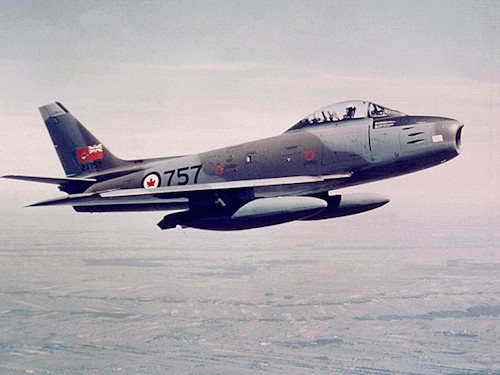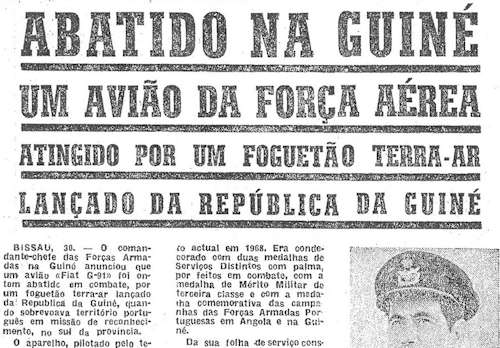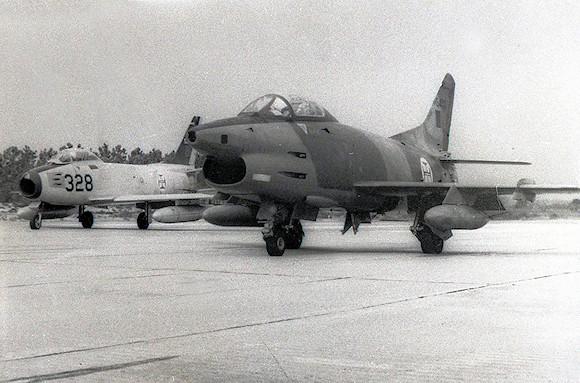In May 1964, the commander in chief of the Portuguese Guinea, General Arnaldo Schultz, with functions also of local provincial governor, had now realized the leap in quality that the guerrilla carried out by the PAIGC (African Party for the Independence of Guinea and of Cape Verde) had set in place to free those lands from the Portuguese colonial domination.
An evolution in front of which the Portuguese armed forces were likely to find themselves unprepared. Under international pressure, and the United States in particular, Portugal had recently been forced to withdraw from the area of fighting the most valuable aircraft at its disposal: the F-86F Sabre obtained through the MDAP program (Mutual Defense Assistance Program).
A jet aircraft that until then had allowed the armies of Lisbon present to react effectively with flexibility and speed to any guerrilla action, while ensuring the role of air defense thanks to its versatile armament and considerable load capacity.
The withdrawal of the F-86F Sabre, until then present on the Monte Real air base with the Permanent 51 Team Detachment, could not be effectively compensated in any way with other models.
They were absolutely not comparable to the F-84G's North American fighter in terms of capacity Thunderjet then present in Angola or, at least, the various propeller aircraft such as the T-6 propeller armored trainers Texan or Lockheed P2V-5 Neptune often temporarily risked on the basis of Ilha do Sal in Cape Verde.
It was therefore necessary to find a solution quickly, also considering that the PAIGC's Marxist separatist guerrilla was not the only one that Portugal had to face in its own African lands. Even in Mozambique and Angola, in fact, there were active strong and combative national liberation movements that increased more and more of capacity and consistency giving a very hard time to the Portuguese armed forces.
 A difficult solution to be identified, given that Portugal was under UN embargo because of its conduct with regard to its colonies in Africa. Given the above, the initial attempt to obtain the Canadair CL-13 from the German Luftwaffe Sabre Mk.6 (photos) of Canadian construction, provided on behalf of CMAP (Canadian Mutual Aid Program), fell on deaf ears due to the veto opposed by the Vancouver government.
A difficult solution to be identified, given that Portugal was under UN embargo because of its conduct with regard to its colonies in Africa. Given the above, the initial attempt to obtain the Canadair CL-13 from the German Luftwaffe Sabre Mk.6 (photos) of Canadian construction, provided on behalf of CMAP (Canadian Mutual Aid Program), fell on deaf ears due to the veto opposed by the Vancouver government.
Other solutions had to be looked for, always interacting with the German aeronautics then interested in forming a training base in the Lusitanian territory. Negotiations that resulted in the 8 of October 1965, the signing of a contract under which Germany undertook to cede to Portugal 40 Fiat G91 model R4 used, but still relatively new, equipped with four machine guns Browning Colt T M3 caliber 12,7 mm, behind the payment of 17,5 millions of brands.
Money that the Portuguese military administration pledged to pay in four different tranches: two in the 1966, a third in the 1968, and the last final in the 1968.
The training of the Portuguese crews began already in November of the same year on the basis of Leipheim (LKG 44), in Bavaria, with the sending of eight pilots so that in December the first former German G91 arrived at the OGMA (General Aeronautical Material Workshops) ) of Alverca.
In Portugal, Fiat fighters were specifically prepared to deal with the particular African operating conditions and, subsequently, four were initially assigned to the old 51 Detachment - already equipped with the Sabre - stationed in Monte Real to complete the transition of all operational pilots intended to operate against the various indigenous guerrillas. Soon the other specimens were progressively dislocated also in Mozambique and Angola as they were delivered.
The baptism of fire in Guinea
The first Portuguese air group to enter active service with the new aircraft was the 121 Squadron Tigres commanded by Lieutenant Egídio Lopes in April 1966 on Base Aérea nº 12 of Bissalanca, in Guinea.
The department commanded by Lopes thus formed a rapid reaction airborne formation aimed, above all, at supporting the action of the terrestrial departments in counter-insurgency operations - even with photo reconnaissance missions - starting from the last quarter of the 1966 when it reached an acceptable operational readiness level.
 Initially, in fact, the operation of the Fiat fighter in the Guinea theater was hampered by multiple malfunctions of the "starter motor" of external launching aircraft. This period was exploited, however, to completely repaint the G91 with a camouflage more suited to African environments, accompanied by the front air intake by a goliardic shark mouth.
Initially, in fact, the operation of the Fiat fighter in the Guinea theater was hampered by multiple malfunctions of the "starter motor" of external launching aircraft. This period was exploited, however, to completely repaint the G91 with a camouflage more suited to African environments, accompanied by the front air intake by a goliardic shark mouth.
Faced with the risk of G91, the PAIGC guerrilla was obviously not watching. Helped by several countries of the communist bloc and, in particular, by Cuban military advisors sent by Castro, she had succeeded in deploying in the 1967 several weapons that could be used as anti-aircraft in the event of an increase in their military activities.
Specifically, these were 37 mm, ZPU-1 and 12,7 mm machine guns.
Armaments that, however, did not prevent the 121 ° Tigres to obtain significant results in the air support missions in favor of ground troops in the 1967, in areas difficult for the high presence of anti-aircraft like Cantanhez and Quitafine.
And all this despite the fact that Guinea-Bissau, although it was small in size and largely within the operational range of the G91 without problems, possessed a climate absolutely hostile to the use of the air and a configuration of the terrain that was well suited to the guerrilla action.
But the situation was always rapidly changing. Starting from the 1968 increased news and reports of air trespass by unidentified aircraft belonging to hostile neighboring states such as Guinea Conakry.
To face them vein decided to start a program aimed at integrating missiles Sidewinder of the F-86F Sabre at the Fiat G91, without however achieving appreciable results.
If the Portuguese could not use the latest technological missiles on their airplanes, the same could not be said for the other party. In Guinea Bissau, in fact, the local liberation movement succeeded in obtaining and using several Strela anti-aircraft systems (SA-7 Grail in the NATO designation).
 Armament with which, in the 1973, managed to bring down the G91 piloted none other than the commander of the group of intervention then in office, Lieutenant Colonel Almeida Brito, while he was in flight with two other jets.
Armament with which, in the 1973, managed to bring down the G91 piloted none other than the commander of the group of intervention then in office, Lieutenant Colonel Almeida Brito, while he was in flight with two other jets.
The event, after the initial surprise, made it necessary to develop new operational tactics in order to deal effectively with this new threat. It was decided that the new missions had to be faced either at a very low altitude or above the 9000 feet at sea level, with recovery from the shooting passes accompanied by evasive maneuvers on the 4G.
In addition to the above measures, it was also decided that after the first major planned maintenance inspection the planes would be repainted with a new olive green livery with significantly reduced national insignia.
But, now, the operational story of the Portuguese G91 in Guinea Bissau was about to end after flying over 10000 hours of combat flight and having suffered the loss of six aircraft and many others damaged.
Mozambique and Angola
In Mozambique were assigned 16 specimens of the Fiat fighter. The first of them arrived in the Portuguese colony towards the end of 1968 by ship to the port of Beira to be then allocated on the Air Base n ° 5 of Nacala. The first nucleus of what was to become the 502 ° Squadron Jaguares was commanded by Captain Fernando Fernandes.
With the expansion of guerrilla actions in the colony the 702 Squadron was also created Escorpiões, which began its operations on the Air Base No. 7 of Tete Chingosi in January 1971, initially commanded by Captain Azambuja da Fonseca.
In addition to the usual counter-fire missions, missions were also carried out using permanent detachments in Porto Amelia, Mueda and Nampula, where the advanced command of the 3 ° Air Region was located. Non-permanent detachments were also carried out at the aerodromes of Nova Freixo, Vila Cabral and Beira.
In the Mozambique operations theater, the activities of the guerrillas were initially concentrated in the districts of Niassa and Cabo Delgado and, later, also in that of Tete. However, it was in the Planalto dos Macondes, an area of dense forests, that there were the major bases of the local liberation movement. In particular, the rebel bases "Beira" between the rivers Mueda and Nangade, "Gun-gunhana" and "Mozambique" in the valley of the river Muer. Destroyed several times but quickly rebuilt easily due to the morphology of the ground, they were also heavily protected with anti-aircraft weapons.
Anti-aircraft weapons including the now omnipresent one arrow, whose first sighting was the 10 April 1974, when it was fired on two G91, but with negative results.
 Also in the 1974, with the proximity of the independence of the province, the withdrawal of the Fiat based in Mozambique took place. The G91s were thus transferred to the Air Base No. 9 located in Luanda, in the other colonial province of Angola, with the help of the Military Airborne Squadron (TAM). This fleet was initially commanded by Captain Damásio Teixeira.
Also in the 1974, with the proximity of the independence of the province, the withdrawal of the Fiat based in Mozambique took place. The G91s were thus transferred to the Air Base No. 9 located in Luanda, in the other colonial province of Angola, with the help of the Military Airborne Squadron (TAM). This fleet was initially commanded by Captain Damásio Teixeira.
During the short period of operations in Angolan territory, between November 1974 and October 1975, the mission assigned was essentially to carry out reconnaissance actions in favor of the troops operating in that theater about the movements of local rebels. Rarely were other tasks assigned to Fiat fighter jets. Sometimes it could happen to have to make some overflights to discourage armed groups from attacking the various fundamental lines of communication present.
For the execution of these missions, detachments were prepared at Negage, Cabinda, Nova Lisboa and Bengue. The only fire action occurred in Angola was put in place in November 1974 against a border post occupied by the Liberation Front of Cabinda located in the anonymous enclave.
Subsequently, the G91 activity waned considerably and was essentially limited to supporting the implementation of the military measures provided for by the Alvor Agreement signed in 1975.
During this period, a bit like a pastime we could say, aerial demonstrations were organized on the bases of Benguela and Luanda, in which the Fiat G91, led by Captain António Gomes, also performed.
But the time of the G91 with the Portuguese insignia in the various African theaters had now come to an end after nine years of service in a combat environment with often very adverse climatic conditions.
The Fiat fighter, in spite of everything, proved to be an excellent light fighter, very versatile in tactical support, even if limited by its short range of action, the reduced load capacity of the armament and the lack of adequate equipment to perform actions night.
(photo: web)












